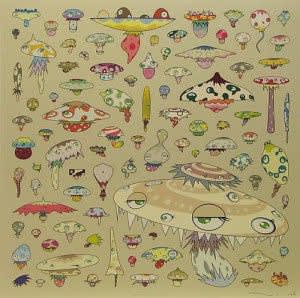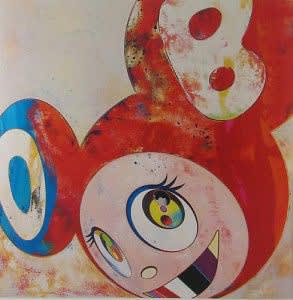Contemporary Art never feels more alive than when we are granted the opportunity to witness the birth of a movement and experience the evolution the master who founded it. Such is the case with Takashi Murakami, a Japanese Pop Artist who will forever be tied to the term he coined − Superflat – in reference to a unique style that blends traditional and modern Japanese elements with a philosophy and commentary about cultural stereotypes.
The Superflat world of Murakami pays homage to the flat, two-dimensional affect of traditional Japanese art and those within modern manga and anime representations as well. In addition to mixing these two styles – which share commonalities but live on opposite ends of the spectrum – the artist also seeks to “flatten” out the consumer audience to whom this style of art appeals.
Similar to Andy Warhol, Keith Haring and other masters of Pop Art, Takashi Murakami is creating a world where “high art” and “low art” intertwine. Like the Pop Artists before him, Murakami’s uses vibrant and bold contemporary colors and lowbrow subjects, lend a sense of accessibility to a mainstream audience. And once again, It’s the context of the works within a framework of social commentary that wins acclaim from critics and collectors alike.
Murakami’s works are often scenes of fantasy with expressive tones that convey a range of emotions. The artist mixes masterful color pallets with extraordinary subjects – ranging from joyful organic characters to psychedelic other-worldly figures – conveying emotional aloofness one moment, confused heaviness the next and pure whimsy the next.
If there’s one place where Takashi Murakami is most similar to Warhol and Haring, it is in the artist’s ability to seize opportunities, manipulate public opinion and attain commercial success. Like Warhol’s Factory and Haring’s Pop Shop, Murakami’s Kaikai Kiki is a company that encompasses the production of paintings, prints, sculptures and assorted works using a variety of media. The company is true to the artist’s Superflat philosophy, producing t-shirts, figurines and a variety of products that makes “high art” commercially available to a mainstream audience. At the same time, Murakami “flattens” the playing field on the other end; turning “ordinary” items into works of “high art” for a thirsty consumer audience that has fallen hard for his unique brand of Pop Art.
Perhaps the most notorious display of Murakami’s commercial success is his collaboration with designer brand Louis Vuitton. Murakami’s re-imagined line of handbags has been a huge commercial success for the fashion brand, while bringing the artist’s international celebrity status to new heights. The collaboration, which was facilitated by designer Marc Jacobs and began in 2002, continues to reap profits for the prestigious brand and artist alike.
At Vertu Fine Art, our Boca Raton gallery currently has a number of Takashi Murakami works for sale. Murakami’s works are simply engaging and fantastic. In the U.S., over the last few years, there has been a resurging interest in Japanese art, particularly manga and anime, and this affinity fuels interest in the works of Murakami. Of course, Takashi Murakami collectors believe that it’s the artist’s influence that has primarily initiated the trend in the first place.
If you are fond of the works of Takashi Murakami, stop in to VFA and have a look at the new works we’ve acquired. And if there’s a particular Murakami you need help sourcing, we are always here to help.


